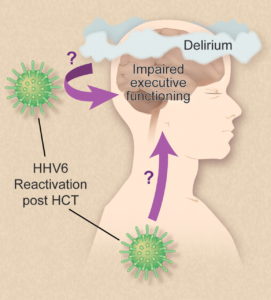Day +21, Saturday, April 23, 2016
WBC: 2.67 k/uL LOW H: 7.6 g/dL LOW P: 21 k/uL LOW BUN: 85 HIGH Cr: 4.9 CRITICAL Na+: 145
Mentation. Dad was sleepy and lethargic when Dr. Ochoa-Bayona, inservice BMT, visited. Yet, Dr. Ochoa-Bayon was able to arouse him. Dad had insensible speech. Dr. Baluch switched Dad from voriconazole, his antifungal therapy, to micafungin due to concern of voriconazole playing a role in Dad’s altered mentation.
An HHV-6 test was ordered.

Illustration by Debra Dartez.
According to the HHV-6 Foundation, Human Herpesvirus 6 (HHV-6) is comprised of two closely related herpes viruses (HHV-6A and HHV-6B) that infect nearly all humans before the age of two. It has a life-long latency and can become reactivated later in life. In some cases, HHV-6 reactivation in the brain tissue can cause cognitive dysfunction, permanent disability and death.
Considered a lumbar puncture (LP; aka spinal tap), which would require Dad’s platelets to be 50 k/uL. LP would test for Epstein-Barr Virus (EBV) in Dad’s central nervous system (CNS).
Blood. Dad had a low grade fever the day before. His PICC line was tested with no negative results. Dad’s arterial blood gas (ABG) showed respiratory Alkalosis (pH 7.49), which is an excessively alkaline condition of the body fluids or tissues.
Lungs. Dad was supplemented with oxygen via mask at 4L. He continued to have strong coughs.
Abdomen. Diarrhea improved. Dr. Ochoa-Bayona wanted an X-ray to confirm the placement of Dad’s feeding tube since Dad had been confused and pulling on his feeding tube. Dad’s feeding was restarted (trickle feed) via feeding tube after X-ray taken.
Kidneys. Urine output improved again. His urine was slightly bloody again since his urinary catheter (aka foley) was replaced. No dialysis was needed since Dad’s creatine/electrolytes were stable.

Recent Comments